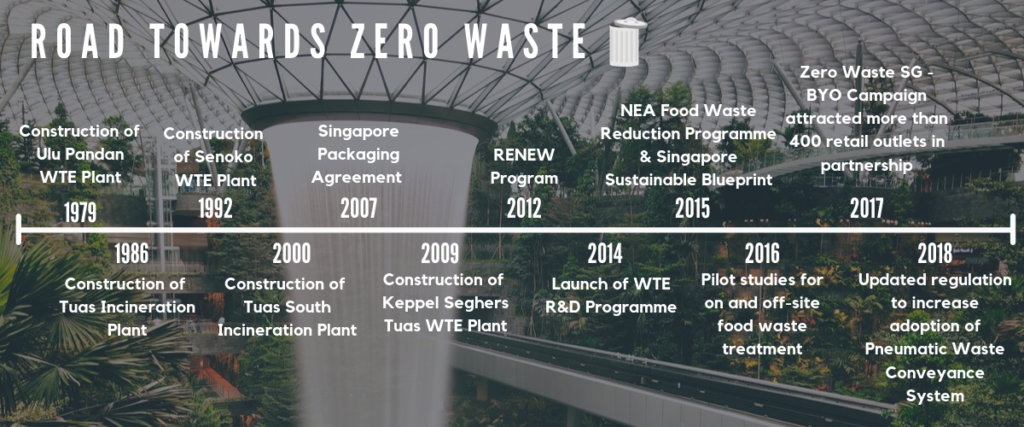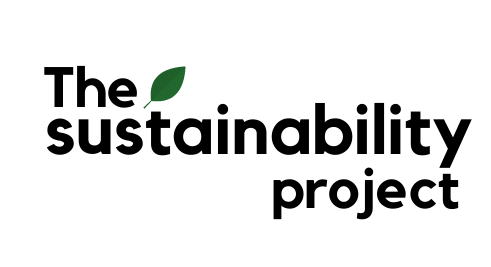It started as an aspiring personal lifestyle among the eco-conscious community, and now it has become a national goal.
In the Year Towards Zero Waste, Singapore aims to reduce the amount of waste disposed into the landfill per capita by 30% by 2030. While it is indeed an ambitious aim, Singapore is not embarking on this journey without a plan.
So how exactly did we end up with that goal in mind?
Well, we delved a little deeper into our Zero Waste Masterplan, published on 30 August this year, which details a thorough set of strategies Singapore will adopt as we work towards developing into a sustainable, resource-efficient and climate-resilient nation.
But before that, let us first understand the history of Singapore’s waste journey!

2019 – Year of Zero Waste
Singapore has recognised the fact that our economic advancement does not make us any less vulnerable to global climate challenges compared our neighbouring countries.
Despite the absence of natural disasters, we have been experiencing intensified extreme weather conditions. This includes more frequent and heavier rainfall and longer dry spells. Severe flash floods in the past few years have also demonstrated how as a low-lying island city-state, we are at the mercy of climate change.
Therefore, Singapore has pledged to play her part by following three key principles for future development:
Economic development, environmental protection and social inclusion are equally important
Everyone must work together to achieve the best outcome
Plans and policies should be focused on the long term and cater to the local context, with an integrated approach to achieve better synergies and resource efficiencies

Waste Statistics 2018 | Image source: Zero Waste Masterplan
Currently, every Singaporean contributes about 0.36kg of waste to our landfill per day. This is a seven-times increase since 40 years ago.
Furthermore, we only have a meager 22% recycling rate for domestic waste. Do you know that approximately 40% of what is thrown into the blue recycling bins are non-recyclable materials?
Compared to 74% recycling rate for non-domestic waste, households are performing poorly in practicing proper recycling habits.
With our very own “Say Yes to Waste Less” and “Recycle right” campaigns, Singapore is garnering the whole nation’s support in moving towards a zero-waste lifestyle.
So what is going to happen in the upcoming years and what should you then expect?
Towards a Zero Waste Nation
2020
NEA is going to implement a mandatory packaging reporting for supermarkets and producers of packaged products.
And from that, they wish to push for an Extended Producer Responsibility (EPR) framework for managing packaging waste including plastics.
This will help greatly in reducing the amount of packaging wastes from its source, considering that one third of domestic waste comprises of packaging waste and more than half of those are plastics.
On average, each Singaporean produces about 11kg of e-waste, which is equivalent to the weight of 73 mobile phones.
While general wastes get incinerated and recyclable wastes get reprocessed, few people know the end-of-life treatment to electronic wastes in Singapore.
2021
Producers, manufacturers and importers of electrical and electronic equipment (EEE) will be required to take responsibility for the end-of-life treatment of their products.
NEA, together with their appointed operator of the Producer Responsibility Scheme, will then collect the e-waste from producers and e-waste bins. These e-waste will be transported to licensed recyclers to ensure that all e-wastes, recycled or not, are accounted for.

Multi-Storey Recycling Facility | Image source: Towards Zero Waste Singapore
To boost domestic recycling rates, Singapore’s first Multi-Storey Recycling Facility (MSRF) will launch in the same year. The recycling of metals, e-waste, paper and plastic will all take place in the same building in close proximity to TimMac @ Kranji.
The aim is to facilitate efforts in reusing and recycling of wastes and by-products from the metals, machinery and timber industries within TimMac @ Kranji. The comprehensive treatment of recyclable wastes will hopefully encourage Singaporeans to practice proper recycling habits.
2030
The government has envisioned for Singaporeans to produce only 0.25kg per day. This will be a major checkpoint to evaluate if the various regulations and campaigns are doing their job in closing the resource loop in our economy.
If Singapore does it right, our zero-waste nation should do Semakau Landfill a huge favour by ensuring its sustainability.
The Future is in Our Hands

Semakau Landfill | Image source: NEA
Without a doubt, Semakau Landfill’s fate depends on everyone’s choices, actions and commitment to leading the zero-waste lifestyle.
So, with all these plans lined up nicely for the near future, how can we as consumers contribute to this national effort?
1) Say Yes to Waste Less
The government will be regulating product packaging in the near future. However, this doesn’t give consumers an excuse to mindlessly purchase packaged products. This doesn’t mean it gives us an excuse to mindlessly purchase packaged products.
We can complement the producers’ efforts by making a conscious effort to buy only what we need, and to choose products that are not over-packaged or unnecessarily packaged.
The Year Towards Zero Waste can also be the year we start cultivating our habit of using reusables. BYO your bottles, cups, utensils and shopping bags! There are plenty of guides out there that consumers can follow to kick start a personal zero waste journey.
2) Recycle Right
Not everything can be suitably reused, but a lot of our wastes are in fact recyclable.
Remember to segregate excess food waste from general wastes. Then, they can be recycled on and off site to produce non-potable water, liquid nutrients, compost or energy.
Some packaging such as plastic bottles and glass jars are sometimes unavoidable. But with a slight rinse and proper disposal into the blue recycling bins, they can be recycled!
Nonetheless, one must always keep in mind that even the recycling process is not 100% efficient; inevitably, traces of materials will still remain after the process.
The best way to achieve zero waste is to refuse unnecessary items such as excess plastic bags. Read more about the Zero Waste Hierarchy and start saying “no” to the un-necessities!
3) Stay committed
2019 is the Year Towards Zero Waste and not just a year of zero waste. With more innovative reusable products emerging in the market, remember that this eco-friendly lifestyle is not just a fad.
Every reusable product you purchase is a conscious decision to reduce as much waste as you can!
While businesses and the government become increasingly accountable for resource use, waste production and waste treatment, our progress towards a zero-waste nation is ultimately dependent on our choices.
We can all do our part in working towards reducing e-waste, plastic waste and eat more sustainably.
Even if you have yet to embark on the zero-waste journey, here’s a guide you can follow to kick start your low waste journey!
As Margaret Mead put it, “Never doubt that a small group of thoughtful, committed citizens can change the world”. So let’s join in on Singapore’s footsteps and march towards a zero-waste future together.


Spot on with this write-up, I actually think this web site wants far more consideration. I’ll most likely be again to learn rather more, thanks for that info.